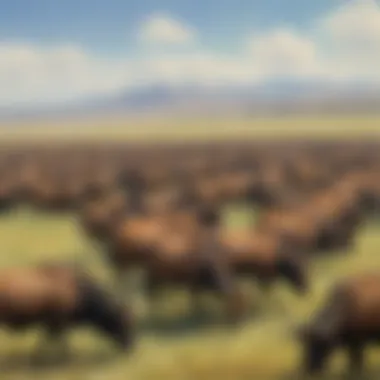Unveiling the Fascinating Wildlife of Grassland Habitats Worldwide


Interactive Learning Games
Grassland habitats offer a unique opportunity to learn about a diverse array of animals and their interactions within this dynamic ecosystem. Through interactive learning games, children can virtually explore the African savannas or the American prairies, discovering the behaviors and adaptations of species like lions or pronghorns. These games not only entertain but also educate, enhancing children's knowledge of wildlife and ecosystems. Reviews of selected educational games provide insights into gameplay mechanics and learning outcomes, emphasizing the importance of experiential learning for cognitive development.
Educational Topics
Tips and Tricks
Parents and educators can leverage grassland habitat animals as a vehicle to enhance children's learning journey. Practical tips include incorporating wildlife documentaries, nature walks, and creative storytelling to engage young learners in exploring animal behaviors and environmental concepts. By making learning fun and interactive, adults can spark children's curiosity and instill a lifelong passion for nature and conservation.
Creative DIY Projects
Engaging DIY projects centered around grassland habitat animals provide children with hands-on opportunities to express creativity and enhance cognitive skills. Step-by-step guides enable kids to construct replicas of their favorite animals, fostering spatial awareness and fine motor skills. Crafting from simple household items reinforces the importance of resourcefulness and ingenuity, promoting artistic expression and individuality in children's development.
Introduction to Grassland Habitats
In this detailed exploration of grassland habitat animals, the focus is placed on understanding the essential elements that define these unique ecosystems. Grasslands, characterized by vast stretches of open fields dominated by grasses rather than large trees, play a crucial role in supporting a diverse array of wildlife globally. This section sets the stage for delving into the various facets of how grasslands shape the lives of the animals that call them home.
Characteristics of Grassland Ecosystems
Climate and Vegetation
The climate and vegetation in grassland ecosystems are pivotal factors that influence the overall dynamics of these habitats. With moderate rainfall and distinct seasons, grasslands are characterized by grasses as the dominant form of vegetation rather than dense forests. This unique feature allows for a high level of biodiversity, supporting herbivores and carnivores alike. The seasonal variability in temperature and precipitation plays a significant role in shaping the life cycles of grassland animals, influencing their feeding patterns and migratory behaviors.
Biodiversity Hotspot
Grasslands are recognized as biodiversity hotspots due to the extensive range of species that thrive in these open environments. The mix of grass species, flowering plants, and shrubs offers a rich tapestry of habitats for numerous animal species. This biodiversity hotspot status promotes the interconnectedness of diverse ecosystems and highlights the critical importance of preserving grasslands to safeguard the wide variety of flora and fauna that depend on them.
Importance of Grasslands
Ecosystem Services
The significance of grasslands lies in the ecosystem services they provide, ranging from carbon sequestration and soil enrichment to water filtration and flood control. Grasslands act as vital carbon sinks, helping mitigate climate change by absorbing atmospheric carbon dioxide. Additionally, the root systems of grasses enhance soil fertility, preventing erosion and promoting sustainable agriculture practices.
Conservation Challenges
Despite their ecological importance, grasslands face pressing conservation challenges, including habitat loss, fragmentation, and overgrazing. Human activities such as agriculture, urban development, and livestock grazing have resulted in the degradation of grassland habitats worldwide. Conservation efforts are essential to protect these valuable ecosystems and the species that rely on them for survival.


Distribution of Grasslands
Global Distribution
Grasslands exhibit a diverse global distribution, spanning continents such as Africa, North America, Australia, and Eurasia. Each region showcases unique variations in grassland types, from the savannas of Africa to the prairies of North America. This widespread distribution underscores the adaptability of grassland animals to thrive in various environmental conditions, reflecting their evolutionary resilience.
Types of Grasslands
There are different types of grasslands, including tropical, temperate, and montane grasslands, each characterized by distinct climate and vegetation patterns. Tropical grasslands, also known as savannas, feature scattered trees and support a wide array of wildlife. Temperate grasslands, found in regions with harsh winters and hot summers, are home to species adapted to extreme temperature fluctuations. Montane grasslands, situated at high altitudes, exhibit specialized flora and fauna adapted to mountainous terrains.
Iconic Grassland Animals
Grassland habitats are home to a diverse array of iconic animals that play pivotal roles in maintaining the delicate balance of these ecosystems. From the majestic lions roaming the African savannas to the swift prairie dogs of North America, these animals have adapted uniquely to thrive in their grassland environments. Understanding the importance of these iconic grassland animals sheds light on the intricate ecological dynamics at play within these vast landscapes.
African Savanna Wildlife
Lions
Lions, known as the kings of the African savanna, hold a significant place in the grassland ecosystem. Their key characteristic lies in their social structure, where they live and hunt cooperatively in prides, showcasing complex familial bonds. This behavior not only aids in communal protection but also enhances hunting success, making lions a beneficial choice for exploring grassland animal dynamics. Despite their hierarchical structure, lions face challenges such as resource competition within prides, reflecting both their advantages and disadvantages in the delicate ecosystem.
Elephants
In the African savanna, elephants stand out for their sheer size and gentle demeanor, yet they play crucial roles in shaping the landscape and biodiversity. Their unique feature lies in their intelligence and intricate communication patterns within herds. This behavioral aspect is advantageous for the survival of the species but can also lead to disadvantages like conflicts over resources. Understanding these dynamics enriches the narrative of grassland animal interactions and ecological significance.
Giraffes
Giraffes, with their towering stature and distinctive long necks, bring a sense of grace to the grasslands. Their key characteristic includes specialized feeding behaviors, enabling them to reach high foliage for sustenance. This uniqueness makes giraffes a popular choice for discussions on grassland animals, highlighting their crucial role in maintaining vegetation balance. However, the disadvantages of their selective diet can pose challenges in times of food scarcity, showcasing the complexities of survival in these dynamic ecosystems.
North American Prairie Fauna
Bison
The bison, often referred to as the icon of the American prairies, symbolizes resilience and adaptation to harsh grassland conditions. Their key characteristic lies in their sheer size and ability to migrate long distances in search of food. This unique feature makes bison a popular inclusion in discussions about iconic grassland animals, emphasizing their vital role in ecosystem maintenance. However, their large herds can lead to overgrazing, resulting in both advantages and disadvantages within the grassland habitat.
Coyotes
Coyotes are skilled predators essential for balancing prey populations in the North American prairies. Their key characteristic includes adaptability to various environments and efficient hunting strategies. This adaptability makes coyotes a beneficial choice for exploring predator-prey dynamics within grassland communities. Despite their advantages in controlling rodent populations, coyotes may face challenges such as habitat loss due to human development, showcasing the delicate balance of their presence in the ecosystem.


Prairie Dogs
Prairie dogs, with their intricate tunnel systems and communal behavior, play vital roles in the prairie ecosystem as keystone species. Their key characteristic lies in their elaborate communication through distinct vocalizations, aiding in sensing threats and coordinating group activities. This unique feature makes prairie dogs an intriguing topic in discussions about grassland creatures, highlighting their importance in ecosystem health. However, their vulnerability to diseases and predation underscores the challenges they face as integral members of the grassland community.
Australian Grassland Creatures
Kangaroos
Kangaroos symbolize the unique fauna of Australian grasslands with their powerful hind legs and distinctive hopping locomotion. Their key characteristic includes adaptive behaviors to thrive in arid environments, showcasing their resilience in challenging habitats. Understanding the advantages and disadvantages of kangaroos in the grassland setting enriches the narrative of adaptation and species survival, offering insights into the diverse strategies employed by these iconic animals.
Emus
Emus, with their tall stature and swift movements, exemplify the agility required to navigate Australian grasslands effectively. Their key characteristic lies in their specialized diets and ability to cover vast distances in search of food and water. This unique feature makes emus a compelling choice for discussions on Australian grassland creatures, emphasizing the complexities of foraging behaviors and habitat utilization. Despite their advantages in mobility, emus may face disadvantages such as competition for resources, highlighting the intricate relationships in the grassland ecosystem.
Koalas
Koalas, renowned for their arboreal lifestyle and eucalyptus diet, represent unique adaptations to the Australian grassland environment. Their key characteristic includes specialized digestive systems for detoxifying eucalyptus leaves, showcasing their coevolution with the region's vegetation. This distinctive feature makes koalas a popular focus in discussions about fauna in Australian grasslands, highlighting their ecological importance and challenges in the face of habitat fragmentation and food availability fluctuations.
: Adaptations of Grassland Animals
In this section of the article, we will delve deep into the crucial topic of adaptations of grassland animals. This segment plays a pivotal role in enhancing our understanding of how wildlife thrives in diverse grassland ecosystems. By focusing on the specific elements of adaptations, benefits, and considerations related to these animals' survival strategies, we gain invaluable insights into the intricate interplay between flora and fauna in these habitats.
: Physical Adaptations
: Camouflage
Camouflage, a standout feature among various physical adaptations, is a fascinating mechanism observed in many grassland animals for evading predators or capturing prey. The key characteristic of camouflage lies in its ability to blend seamlessly with the surrounding environment, rendering the animal practically invisible to potential threats. By exploring the unique features of camouflage and its advantages in allowing survival in grasslands, we unravel the remarkable adaptation skills of these creatures.
: Speed and Agility
Speed and agility serve as vital components of physical adaptations in grassland animals, aiding in predator evasion or successful hunting pursuits. The essence of these traits lies in their ability to outmaneuver threats swiftly and effectively. By highlighting the unparalleled quickness and nimbleness exhibited by these animals, we discern the significance of speed and agility as preferred traits in the survival toolkit within grassland environments.
: Behavioral Strategies
: Migration Patterns
Migration patterns form an essential behavioral strategy adopted by many grassland animals to cope with changing environmental conditions and resource availability. The distinctive characteristic of migration patterns is their facilitation of long-distance movements in search of sustenance or suitable breeding grounds. By examining the advantages and disadvantages associated with migration patterns in the context of grassland habitats, we uncover the adaptive behaviors crucial for species survival.


: Social Structures
Social structures represent another key behavioral strategy prevalent among grassland animals, shaping their interactions and group dynamics within the ecosystem. The fundamental feature of social structures lies in fostering cooperation, communication, and division of labor among individuals. By elucidating the unique aspects of social hierarchies and communal behaviors, we gain valuable insights into the complexities of animal socialization and its impact on grassland communities.
: Feeding Habits
: Herbivores vs. Carnivores
The distinction between herbivores and carnivores in grassland ecosystems plays a pivotal role in shaping the food web and energy flow within these habitats. The key characteristic of this aspect lies in the dietary preferences and hunting strategies adopted by herbivores and carnivores, respectively. By exploring the unique feeding behaviors and ecological roles of herbivores versus carnivores, we unravel the delicate balance maintained by these diverse feeding guilds in sustaining the grassland ecosystem.
: Specialized Diets
Specialized diets denote a distinct feeding habit observed in certain grassland animals, whereby they have evolved to consume specific plant species or prey items. The key characteristic of specialized diets lies in the specialized anatomical adaptations and behavioral patterns tailored to exploit niche food sources efficiently. By delving into the unique features and nutritional advantages of specialized diets in grassland creatures, we appreciate the diversification of feeding strategies contributing to ecosystem resilience and species diversity.
Interactions in Grassland Communities
In the rich tapestry of the grassland ecosystem, understanding the interactions that occur within the community is crucial for comprehending the delicate balance of nature. The intricate web of relationships between different species not only shapes the ecosystem but also highlights the interdependence prevalent in these habitats. By exploring the interactions in grassland communities, we can unravel the complexities of how predators, prey, competitors, and symbiotic partners coexist and contribute to the dynamic equilibrium of these environments.
Predator-Prey Dynamics
Predation strategies
Delving into the realm of predation strategies unveils a fascinating aspect of the grassland ecosystem. Predation, as a pivotal ecological process, influences population dynamics and maintains species diversity. The stealth, speed, and ambush techniques adopted by predators showcase their evolutionary adaptations for securing sustenance. This section delves into the key characteristic of predation strategies – the selective pressure it exerts on prey populations, driving evolutionary adaptations such as camouflage, speed, and defensive mechanisms. By elucidating the unique features of predation strategies, we gain insights into the efficiency of predator-prey interactions and their significance in shaping grassland communities.
Survival techniques
Survival techniques employed by prey species exemplify their evolutionary responses to predation pressure in grassland habitats. From rapid flight to cryptic behavior, survival strategies serve as mechanisms for evading predators and ensuring reproductive success. This section emphasizes the adaptive significance of survival techniques, highlighting how prey species mitigate predation risk through vigilance, group behavior, and vigilance. Understanding the advantages of these survival tactics offers a glimpse into the intricate dance between predators and prey, shedding light on the strategies that define survival in the dynamic grassland communities.
Competitive Relationships
Exploring the competitive relationships among species within grassland habitats uncovers the complex mechanisms underlying resource acquisition and territoriality. Competition for limited resources such as food, water, and shelter drives evolutionary adaptations and influences population dynamics. By elucidating the dynamics of resource competition and territorial disputes, we can grasp the strategies employed by species to optimize their access to essential resources. This section delves into the key characteristic of competitive relationships – the role of competition in structuring community composition and influencing species distribution. Through a nuanced exploration of resource competition and territorial disputes, we unveil the intricate balance of power and survival tactics that govern the competitive landscape of grassland ecosystems.
Resource competition
Resource competition lies at the heart of ecological interactions within grassland communities, shaping species abundance and distribution. The intense competition for resources compels species to evolve different foraging strategies, feeding behaviors, and spatial utilization patterns. This section illuminates the unique feature of resource competition – the impact of resource availability on species interactions and community structure. By elucidating the advantages and disadvantages of resource competition, we gain a deeper understanding of the ecological mechanisms driving species coexistence and diversity in grassland environments.
Territorial disputes
Territorial disputes among individuals or groups reflect the need to establish and defend exclusive access to key resources in grassland habitats. Territoriality serves as a mechanism for reducing intraspecific competition and ensuring optimal access to breeding sites, feeding grounds, and nesting locations. This section highlights the key characteristic of territorial disputes – the negotiation of space and habitat quality to enhance reproductive success and survival rates. By exploring the unique features of territorial behavior, we unravel the adaptive strategies employed by species to secure territorial boundaries and maintain reproductive fitness in the competitive realm of grassland communities.
Symbiotic Partnerships
The intricate interplay of symbiotic partnerships in grassland habitats underscores the mutualistic interactions and cooperative behaviors that drive ecological sustainability and species coevolution. Mutualistic relationships between species enhance nutrient cycling, seed dispersal, and pest control, providing adaptive advantages for both partners. Cooperative behaviors such as collaborative hunting, alarm calling, and mutual defense confer evolutionary benefits, fostering group cohesion and enhancing survival rates. This section delves into the key characteristic of symbiotic partnerships – the mutual benefits derived from cooperative interactions and mutualistic relationships. By examining the unique features of mutualistic interactions and cooperative behavior, we gain a profound appreciation for the synergies that underpin the resilience and biodiversity of grassland ecosystems.















